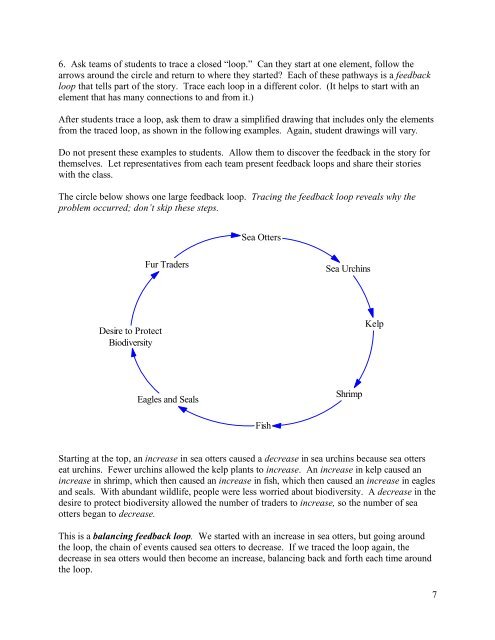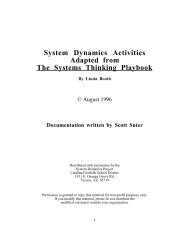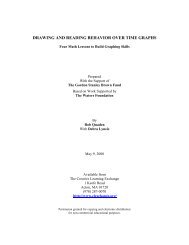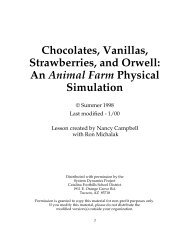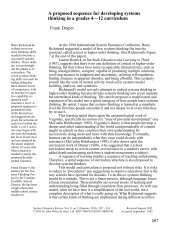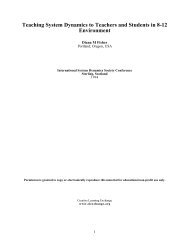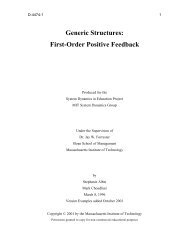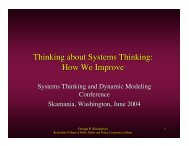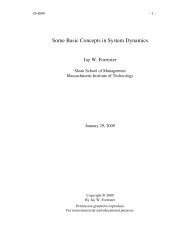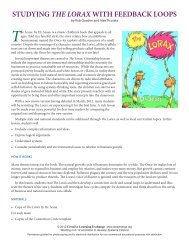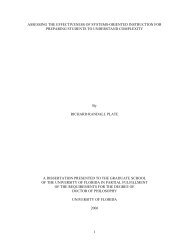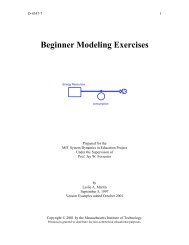Keystone Species in an Ecosystem Using Connection Circles to Tell ...
Keystone Species in an Ecosystem Using Connection Circles to Tell ...
Keystone Species in an Ecosystem Using Connection Circles to Tell ...
Create successful ePaper yourself
Turn your PDF publications into a flip-book with our unique Google optimized e-Paper software.
6. Ask teams of students <strong>to</strong> trace a closed “loop.” C<strong>an</strong> they start at one element, follow thearrows around the circle <strong>an</strong>d return <strong>to</strong> where they started? Each of these pathways is a feedbackloop that tells part of the s<strong>to</strong>ry. Trace each loop <strong>in</strong> a different color. (It helps <strong>to</strong> start with <strong>an</strong>element that has m<strong>an</strong>y connections <strong>to</strong> <strong>an</strong>d from it.)After students trace a loop, ask them <strong>to</strong> draw a simplified draw<strong>in</strong>g that <strong>in</strong>cludes only the elementsfrom the traced loop, as shown <strong>in</strong> the follow<strong>in</strong>g examples. Aga<strong>in</strong>, student draw<strong>in</strong>gs will vary.Do not present these examples <strong>to</strong> students. Allow them <strong>to</strong> discover the feedback <strong>in</strong> the s<strong>to</strong>ry forthemselves. Let representatives from each team present feedback loops <strong>an</strong>d share their s<strong>to</strong>rieswith the class.The circle below shows one large feedback loop. Trac<strong>in</strong>g the feedback loop reveals why theproblem occurred; don’t skip these steps.Sea OttersFur TradersSea Urch<strong>in</strong>sDesire <strong>to</strong> ProtectBiodiversityKelpEagles <strong>an</strong>d SealsShrimpFishStart<strong>in</strong>g at the <strong>to</strong>p, <strong>an</strong> <strong>in</strong>crease <strong>in</strong> sea otters caused a decrease <strong>in</strong> sea urch<strong>in</strong>s because sea otterseat urch<strong>in</strong>s. Fewer urch<strong>in</strong>s allowed the kelp pl<strong>an</strong>ts <strong>to</strong> <strong>in</strong>crease. An <strong>in</strong>crease <strong>in</strong> kelp caused <strong>an</strong><strong>in</strong>crease <strong>in</strong> shrimp, which then caused <strong>an</strong> <strong>in</strong>crease <strong>in</strong> fish, which then caused <strong>an</strong> <strong>in</strong>crease <strong>in</strong> eagles<strong>an</strong>d seals. With abund<strong>an</strong>t wildlife, people were less worried about biodiversity. A decrease <strong>in</strong> thedesire <strong>to</strong> protect biodiversity allowed the number of traders <strong>to</strong> <strong>in</strong>crease, so the number of seaotters beg<strong>an</strong> <strong>to</strong> decrease.This is a bal<strong>an</strong>c<strong>in</strong>g feedback loop. We started with <strong>an</strong> <strong>in</strong>crease <strong>in</strong> sea otters, but go<strong>in</strong>g aroundthe loop, the cha<strong>in</strong> of events caused sea otters <strong>to</strong> decrease. If we traced the loop aga<strong>in</strong>, thedecrease <strong>in</strong> sea otters would then become <strong>an</strong> <strong>in</strong>crease, bal<strong>an</strong>c<strong>in</strong>g back <strong>an</strong>d forth each time aroundthe loop.7


